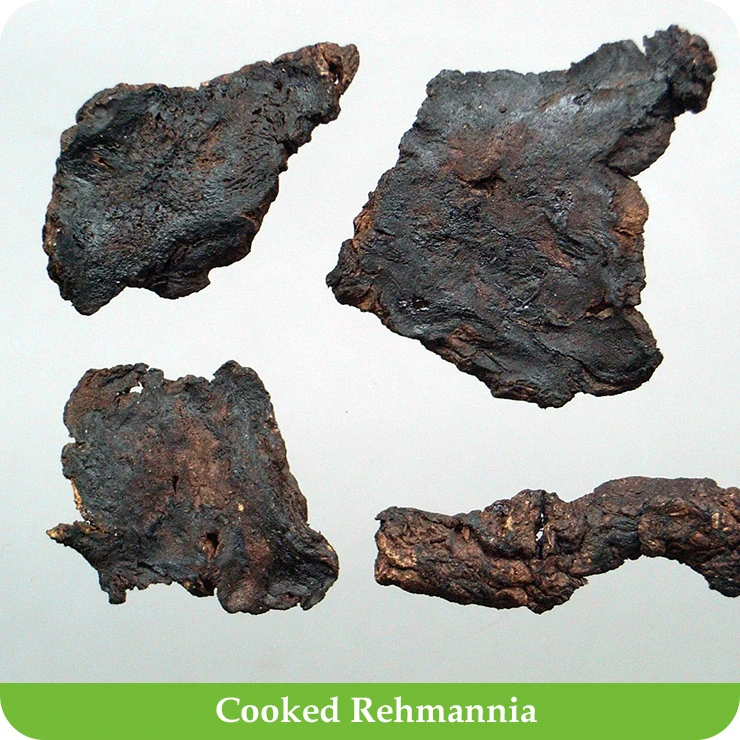Rehmannia is a Chinese medicine name. Rehmannia glutinosa Libosch. Fresh or dried root tubers. Harvest in autumn, remove the reed head, fibrous roots, and sediment, fresh or processed for use. It is divided into fresh Dihuang, dry Dihuang, and cooked Dihuang.
On August 26, 2024, the National Health Commission and the State Administration for Market Regulation issued an announcement, including Rehmannia as a substance that is traditionally both food and Chinese herbal medicine.
Nature and taste
1, fresh Rehmannia: tastes sweet, bitter, and cold.
2, dry Rehmannia: sweet taste, cold.
3, cooked Rehmannia: sweet taste, mild.

Channel tropism
1, fresh Dihuang: heart, liver, kidney channel.
2, dry Dihuanga: heart, liver, kidney channel.
3, cooked Dihuang: liver, kidney channel.

efficacy
1. Fresh Rehmannia: clearing heat-promoting fluid, cooling blood, and stopping bleeding.
2. Dry Rehmannia: clearing heat and cooling blood, nourishing Yin, and promoting fluid.
3, cooked Rehmannia: blood nourishing Yin, essence filling marrow.

The main functions of a disease
1, fresh Rehmannia: used for fever injury Yin, tongue Jiang thirst, warm poison hair spot, vomiting blood, epistaxis, sore throat.
2, dry Rehmannia: used for heat into the yin blood, warm poison hair spot, vomiting blood, epistaxis, fever injury Yin, know Jiang dysphoria, constipation, sore throat.
3, cooked Rehmannia: for blood deficiency and yellows, palpitation, and palpitation, irregular menstruation, bleeding blood, liver and kidney Yin deficiency, waist and knee tenderness, bone steam hot, night sweats and spermatogenesis, internal heat and thirst, vertigo, tinnitus, chin early white.
Usage and dosage
1, fresh Rehmanniae Radix, 12 ~ 30g.
2, dry Rehmanniae Radixa, 10 ~ 15g.
3, cooked Rehmanniae Radix, 9 ~ 15g
Processing method
1, fresh Rehmanniae Radix, dry Rehmanniae Radix: remove impurities, wash, dull and moist, cut thick pieces, dry.
2, Prepared Rehmanniae Radix: (1) Take raw Rehmanniae Radix, stew according to the wine stew method until the wine is sucked up, take out, dry until the skin mucus is slightly dry, cut thick pieces or pieces, dry, ready. (For every 100kg of raw rehmannia, use 30 ~ 50kg of rice wine.) (2) Take raw rehmandra, steam it until it is dark and moist, take it out, sun it until it is about 80% dry, cut it into thick slices or pieces, and dry it.
Physiological characteristics
1. Fresh Rehmanniae Radix: Spindle shape or strip shape, 8 ~ 600px long, 2 ~ 225px diameter. The skin is thin. The surface is light red and yellow, with curved longitudinal wrinkles, bud marks, 7L-like protrusions, and irregular scars. Fleshy, and easy to break, the skin of the section is yellowish-white, orange oil spots can be seen, the wood is yellowish-white, and the catheter is arranged radially. Gas tastes slightly sweet and slightly bitter.
2, raw Rehmanniae Radix: mostly irregular clumps or oblong, expanded in the middle, slightly thin at both ends, some small, long, slightly flat and twisted, 6 ~ 300px long, 2 ~ 150px diameter. Surface brownish black or brownish gray, extremely wrinkled, with irregular curved lines. Weight, soft and tough quality, not easy to break, cross-section brown black or black, shiny, sticky. Slightly airy, and slightly sweet.
3, cooked Rehmanniae Radix: irregular pieces, pieces, size, and thickness are different. The surface is black, shiny, and sticky. Soft and ductile, not easy to break, black section, shiny. Slight air, a sweet taste.







